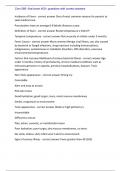Cmn 568- final exam 400+ questions with correct answers
Incidence of Fever - correct answer One of most common reasons for parents to
seek medical care.
Preschoolers have an average 6-8 febrile illnesses a year.
Definition of fever - correct answer Rectal temperature ≥ 100.4°F
Tympanic temperature - correct answer Not accurate in infants under 3 months
Fever Causes - correct answer Most common Benign viral illness, can also caused
by bacterial or fungal infections, drug reactions including immunizations,
malignancies, autoimmune or metabolic disorders, CNS disorders, excessive
environmental temperatures.
Factors that increase likelihood of serious bacterial illness - correct answer Age
under 3 months, history of prematurity, chronic medical conditions such as
immunosupression or aspenia, previous hospitalizations, daycare. Toxic
appearance
Non-Toxic appearance - correct answer Strong cry
Consolable
Alert and easy to arouse
Pink skin tones
Good hydration; good turgor, tears, moist mucous membranes
Smiles, responsive to environment
Toxic appearance - correct answer Weak or high pitched cry
Inconsolable
Difficult to arouse
Pale, ashen, cyanotic, or mottled skin tones
Poor hydration; poor turgor, dry mucous membranes, no tears
No smile, listless, dull, infant won't alert to environment
Signs of serious illness - correct answer Fever greater than 40 (105)
,Cmn 568- final exam 400+ questions with correct answers
Nuchal rigidity
Petechial skin rash
Seizure activity
Stridor or increased WOB
Physical exam signs of serious infection: Skin - correct answer Petechiae, rashes
Physical exam signs of serious infection: head/neck - correct answer Sunken or
bulging fontanelles, nuchal rigidity
Physical exam signs of serious infection: ears - correct answer Bulging TM, AOM,
mastoiditis
Physical exam signs of serious infection: Chest - correct answer Tachypnea,
wheezing, rales, rhonchi
Physical exam signs of serious infection: Heart - correct answer Murmurs
Physical exam signs of serious infection: Abdomen - correct answer Tenderness,
distension
Physical exam signs of serious infection: Musculoskeletal - correct answer Refusal
to bear weight or use an extremity, erythema/warmth over joint
Diagnostic tests for fever in infant and young child - correct answer CBC w/ Diff
(WBC > 15,000 may indicate SBI. Child with overwhelming sepsis my have WBC
<5,000)
UA/ C&S: R/O UTI
CXR: R/O Pneumonia
Lumbar Puncture: R/O meningitis
Blood cultures: R/O Bacteremia
Stools for C&S: R/O Infectious diarrhea
Management of fever in infant < 4 weeks - correct answer Refer to pediatrician
Hospitalization
,Cmn 568- final exam 400+ questions with correct answers
Full septic workup
IV antibiotics pending culture results
Management of fever in infant 4 weeks - 3Mo - correct answer Toxic appearance:
Refer to pediatrician
Hospitalization
Full septic workup
IV antibiotics pending culture results
Non-Toxic appearance/No risk factors for SBI:
Full septic workup
Specific treatment for any diagnosed conditions
Empiric antibiotics after cultures: Rocephin 50mg/kg/day (up to 1 gm max)
Must have reliable caregiver with phone and transportation
Close followup in 24 hours
Management of fever in 3Mo to Preschool - correct answer Toxic appearance:
Septic work up
Consider hospitalization and IV antibiotics, especially if no focal source of fever
can be identified
Non-Toxic appearance:
Lab work up guided by H&P
CBC with Diff
CXR if cough or dyspnea
Stool C&S if diarrhea
UA: all girls under 2yo, all males under 6Mo, uncircumcised males under 12Mo
Non-Toxic appearance:
Fever <39 (102) no obvious source: Antipyretics, close followup by visit or phone
, Cmn 568- final exam 400+ questions with correct answers
Fever >39 (102) antipyretics, consider empiric antibiotics, close followup by visit
or phone
Antipyretic - correct answer Acetaminophen: 10-15mg/kg Q 4-6 Hrs (Max 5 doses
in 24 hours)
Ibuprofen: 5-10mg/kg Q 6-8hrs (max 40mg/kg/day)
Never use aspirin
Educate parents on risk of overdosing and review concentration information.
Fever-Home Care - correct answer Increased fluids to maintain hydration
Light clothing/blankets to help reduce fever
Tepid sponge baths if fever unresponsive to antipyretics
No alcohol or cold water baths
Parents should check every 4 hours for: Temp, activity level, fluid intake and
report any change in condition to medical provider
Fever - Follow up - correct answer Close follow up is essential for safe out-patient
management of fever in infants and young children
Follow up by office visit or phone in 24 hours
Follow up on all labs and cultures and focus treatment on any positive findings
Proper otoscope technique - correct answer Always brace finger against patients
cheek
Adult: Pinna up and back
Peds: Pinna down and back
Normal Otoscope View - correct answer Malleus, Umbo, Cone of light
Cone of light at 7 o'clock in left and 5 o'clock on right
Cone of light disappears when there is fluid
Otitis Externa - correct answer Cellulitis of the soft tissues of the external auditory
canal




